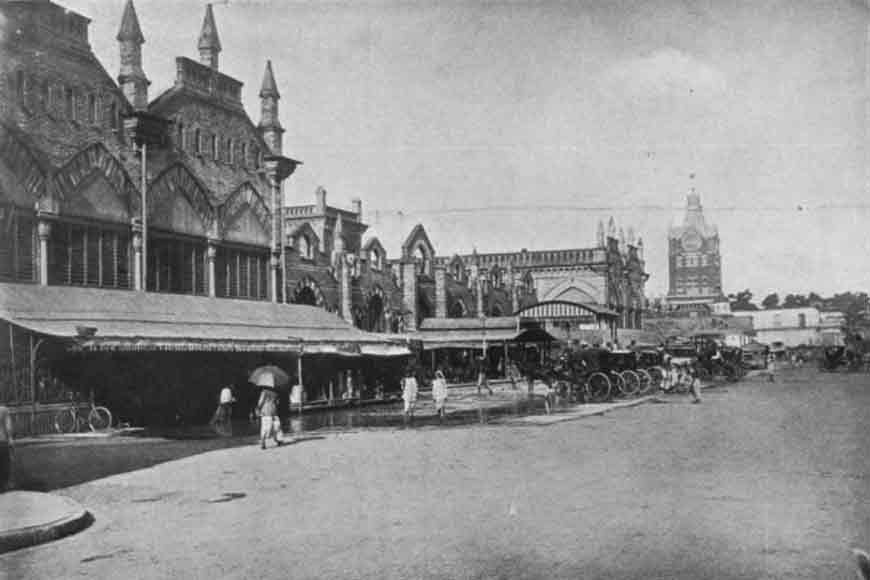Of ‘Bagans’ and ‘Bazaars’: Old Calcutta and its place names

New Market-1905
In the first part of this article, which you can read here, we started out with old Calcutta neighbourhoods bearing the suffixes ‘tala’, ‘tola’ and ‘para’, as an indication of the predominant professional communities inhabiting the city, as well its geography, in the 17th and 18th (and part of the 19th) centuries. Continuing in the same vein, it is fairly easy to see how important trade and commerce were to the growth of the city from a few more place names.
Take the suffix ‘bazar’, which literally means market in Bengali. In this category, you will broadly see two kinds of names - those associated with particular individuals, and those associated either with geographical markers or specific communities. So ‘Territi Bazar’ is actually Tiretta Bazar, named after Italian entrepreneur Edward Tiretta, who was forced to escape his native Venice following a mysterious political scandal and finally landed up in Calcutta; or ‘Hogg’s Bazar’ which became New Market; or ‘Janbazar’, which was originally ‘John Bazar’; or ‘Chine Bazar’, a variation of China Bazar, where the Chinese community sold their wares; or Mechhua Bazar, presumably derived from ‘mechhua’ or fisherman, owned and managed since 1775 by a certain Francis D’Mello.
 Shyambazar
Shyambazar
The fact that local markets were under European management ought to tell you how big a source of revenue they were. Yet another example is Sherburne Bazar, set up around 1785 by Joseph Sherburne, roughly corresponding to the plot of land on which Chandni Market stands today. From contemporary records, it appears that Sherburne appealed to Governor General Warren Hastings in 1782 for permission to open a public bazaar on this plot, which he had bought from Gokulchandra Mitra.
Shyam Bazar, now one of the city’s most prominent locations, apparently started life as Charles Bazar (according to Holwell’s account). And several sources say that it was renamed Shyam Bazar in honour of Lord Krishna by Sobharam Bysack (Basak), a scion of one of the wealthiest families of Sutanuti in the 18th century.
There is the self-explanatory ‘Burra Bazar/Boro Bazar’, ‘burra’ in Hindi and ‘boro’ in Bengali both meaning large. But there are also names like Lalbazar or Radhabazar, whose origins are shrouded in mystery. While some chroniclers say the name Lalbazar comes from its proximity to ‘Lal Dighi’ or the tank in erstwhile Tank Square (BBD Bag today), others say it may be a derivative of ‘Loll Bazar’, from the British pronunciation of ‘lal sharab’ or red wine, which became ‘loll shraub’. This was the watering hole of the city, brimming with taverns and punch houses, hence the abundance of ‘lal sharab’.
Owing to its urban nature from the very beginning, Calcutta was more comfortable with a bazaar than a ‘haat’, or small rural market. Nonetheless, at its very inception, the city did have a few ‘haats’ which gradually went out of existence, leaving only their names behind. The list includes ‘Murgihata’ next to China Bazar, where ‘murgi or chicken was presumably once the principal commodity; ‘Darmahata’ near Burra Bazar, once known for its ‘darma’ or bamboo ware, ‘Garanhata’ at the crossing of Chitpur Road and Beadon Street, clearly once a hub for wood and wooden products, ‘garan’ being a species of tree native to mangrove areas which produces hardy timber.
 Territi Bazar
Territi Bazar
One more common suffix in these old place names is ‘bagan’. Before the pressure of a rapidly growing population made land a premium commodity in Calcutta, wealthy citizens would build large homes for themselves, with a spacious ‘bagan’ or garden being almost mandatory. Neighbourhoods with a relative abundance of such residences would become identified as something-or-the-other bagan - Chaltabagan, Hartakibagan, Goabagan, Peyarabagan, Raybagan, Hatibagan, Sikdarbagan, Halmibagan (named after the hargila bird, a species of stork) et al.
Interestingly, the still extant neighbourhood of Kalabagan seemingly had nothing to do with ‘kala’ or bananas. More than one historian has said that the name derives from ‘kalabagh’, the word for currency counterfeiter or fake currency maker in Persian.
To the north of Kalabagan is Thanthania or Thanthaney, which was apparently the word used to describe street magicians, tricksters, and monkey performances, which should give you an idea of the people inhabiting the area. Adjoining it is Chorbagan, ‘chor’ meaning thief. The cohabitation makes sense.
We have, of course, left out huge chunks of the city from our brief study. Hopefully, we can do those rounds some other day.











